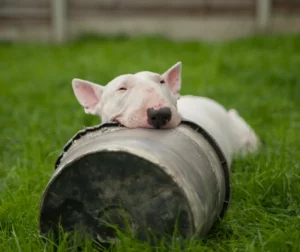Poisoning in dogs is more and more frequent and is a common cause of death. In addition, it is the species most often poisoned, especially the youngest.
Poisonings are more often seen in the summer and during the holidays in December. This is why pet owners need to be able to prevent the risk of poisoning. Your dog could ingest potentially toxic food or chemicals that you may have around the house.
In this article, you will be able to identify foods, chemicals, and drugs that are toxic to your pet. In addition, you will know how to recognize the signs of poisoning and what you can do to help your pet.
Which Foods Can Cause Food Poisoning in Dogs?
Pets are constantly exposed to all kinds of toxic foods, even if they are completely harmless to humans. Even small amounts of certain foods can cause serious health problems.
Here’s a list of ingredients toxic to dogs:
- Avocado
- Eggplant
- Candy
- Chocolate
- Garlic
- Grapes
- Leeks
- Nuts (i.e. macadamia, almond)
- Onion
- Seeds (i.e. apple, pomegranate)
- Stones (i.e. apricot, cherry, pear)
- Raw potato
- Tomato
Eggplant, Raw Potato, and Tomato
Eggplant, raw potato, and tomato contain solanine. It is a toxic and potentially fatal alkaloid for the dog. We find higher concentrations of this molecule among potatoes that have sprouted, are damaged, or are green. Moreover, this toxin remains present even after cooking. Thus, potato cooking water and peels should never be given to your pet.
For tomatoes, solanine is present mainly in green tomatoes, in the leaves of the plant, and in its stems. The concentration of solanine decreases considerably when the tomato becomes ripe.
Although the ripe tomato presents no health problem for humans, it is still harmful to animals. Because of this, even a small amount of solanine can cause them serious health problems.
Solanine poisoning can occur 2 to 19 hours after ingestion.
The most common symptoms of solanine poisoning are:
- Anxiety
- Diarrhea
- Hypersalivation
- Opisthotonos (contraction of posterior muscles)
- Tremors
- Vomiting
- Seizures
Garlic, Onion, and Leeks
Garlic, onion, shallot, chives, green onion, and leeks are part of the Allium family. They have many nutritional benefits for humans, but they are toxic to cats, dogs and ferrets. Whether raw, cooked, dehydrated, or in baby food jars, they are still unsuitable for animal consumption.
These foods poison the blood and can therefore destroy red blood cells. This is what impedes oxygen transport and leads to anemia. Signs of poisoning may appear after 1 or 2 days. In addition, some dog breeds are more susceptible to this toxicity than others.
In cats, as little as 5 g of onion per kg of body weight is enough to cause serious health problems. For the dog, it is 15 to 30 per kg of body weight. In other words, poisoning can occur if the animal consumes more than 0.5% of its weight in onions.
Here are the related symptoms of Allium poisoning:
- Anorexia
- Diarrhea
- Breathing difficulties
- Weakness of the hindquarters
- Muscular weakness
- Dark red or brown urine
- Vomiting
Avocado
Avocado is toxic to dogs, cats, and many other animals. This is due to persin, an unsaturated fatty acid, which animals have trouble metabolizing. Its pit, skin, and leaves are also poisonous and can cause death.
Signs of poisoning appear between 1 to 24 hours after ingestion. It all depends on the dose ingested.
Like most poisoning symptoms, your pet may show signs of:
- Diarrhea
- Vomiting
- Fatigue
- Loss of appetite
- Respiratory disorder
- Cardiovascular disorder
The toxic dose is not yet known, but an animal would have to ingest a large quantity of avocado or eat the plant to poison itself.
Candies
Candy can contain xylitol and even a small amount can have serious effects. It is a much more common sugar substitute than you might think.
It is often found in low-sugar or sugar-free foods like peanut butter, yogurt, ice cream, and even toothpaste. That’s why it’s important to always check the ingredient list to make sure they’re safe for your pet. Signs of intoxication may appear 30 minutes after ingestion of xylitol and cause severe hypoglycemia.
Here are some clinical signs of xylitol poisoning:
- Ataxia (balance disorder)
- Depression
- Seizures
- Weakness
- Hepatic insufficiency
Even if the candy does not contain xylitol, sugar is still not recommended. It can cause overweight, diabetes, and rotted teeth, just like in humans. Over time, diabetes can make your dog blind.
Chocolate
Cocoa is toxic to cats and dogs because it contains theobromine. It is a molecule similar to caffeine that they cannot assimilate. This means dark chocolate is particularly toxic to your pet.
By the way, a chocolate bar could be fatal, depending on your pet’s weight and if he had an empty stomach. On the other hand, white chocolate would have to be consumed in large quantities to cause poisoning.
The lethal dose for a dog is 100 mg per kg of body weight. For example, for a 22 lbs dog, 150g of dark chocolate or 1000g of milk chocolate can be fatal.
Chocolate poisoning is manifested by:
- Tremors
- Vomiting
- Salivation
- Increased thirst
- Panting
- Restlessness
- Frequent urination
Pits, Nuts, and Seeds
Plants and fruits of the Rosaceae and Linaceae families contain cyanogenic glycosides. Once ingested, these plant toxins produce highly toxic hydrogen cyanide. In these families, we find almonds, pear pits, apple seeds, flax seeds, and several other plants.
However, it would require consumption in large quantities to cause cyanide poisoning. Therefore, the consumption of a core could obstruct the respiratory or gastrointestinal tracts.
Depending on the dose ingested, your pet could suffer from:
- Diarrhea
- Dyspnea (difficulty breathing)
- Hypothermia
- Cyanosis (discoloration of the skin)
- Seizures
- Vomiting
Grapes
Whether red or white, ingesting grapes can cause very severe kidney failure. This includes any fruits that come from the Vitaceae family like gooseberries. The toxin is still unknown today, but it would be present in the flesh of the fruit and not in the seed.
Most cases of poisoning are due to ingesting grapes raw or in the form of fruitcakes, pies, chocolate bars, or granola bars. Additionally, some dogs and cats are more tolerant of grapes than others.
On average, 10 to 57 g of grapes per kg of body weight could be fatal. By the way, raisins are even more toxic. Just 6 raisins could cause danger to your pet’s health.
The first signs of poisoning can occur 6 to 12 hours after ingestion. Kidney failure can occur 24 to 72 hours after ingestion.
The signs of poisoning are:
- Anorexia
- Anuria (absence of urine)
- Depression
- Dehydration
- Diarrhea
- Lethargy (des and prolonged sleep)
- Nausea
- Oliguria (low urine production)
- Vomiting
What Chemicals Can Cause Poisoning in Dogs?
Rat poison
Products such as rodenticides are anticoagulant poisons. These poisons interfere with the use of vitamin K, which is used for blood clotting. As a result, your pet can experience serious respiratory and liver problems that can lead to rapid death.
Due to their sweet taste, rats, and dogs are attracted to this poison. If you suspect your pet has ingested rat poison, consult your veterinarian even if he has no symptoms.
Here’s a list of symptoms of rat poison poisoning:
- Anorexia
- Breathing difficulty
- Cough
- Cardiac disorders
- Hemorrhages
- Locomotor difficulty
- Pale mucous membranes
- Seizures
- Weakness
Detergent
This includes products that contain soap as well as very diluted bleach. For example, detergent, shampoo, laundry soap, and any other household product. On the other hand, if it is a concentrated soap, such as dishwasher tablets, then it is considered to be a strong acid. It’s called a caustic and bleach is one of them. If your pet has ingested a caustic, the repercussions can be serious.
Detergents are products that can irritate the skin and mucous membranes. Your pet could accidentally get it on his skin or in his eyes and lick it off. The first symptoms may appear after a few minutes or after a few hours following contact with it. The toxicity of detergents depends on the type of products, as well as the quantity ingested.
After ingestion, you may see hypersalivation and vomiting. In rare cases, ingesting detergent could cause diarrhea. He could also have serious lung consequences that can prevent him from breathing.
If your pet has had detergent on their skin, they may be very uncomfortable and scratched. By doing this, he could cause inflammation, and skin damage and infect his wound by scratching. He could also have erythema or skin necrosis if the product stays on his skin too long.
If he got detergent in his eyes, he could have conjunctivitis as well as abnormal or excessive tearing. The detergent could also cause the eyelids to close involuntarily or create an ulcer.
Which Human Medications Can Cause Poisoning in Dogs?
Acetaminophen, Aspirin, Ibuprofen and Paracetamol
These are very powerful nonsteroidal anti-inflammatory drugs that can be quickly fatal. Ingestion can be accidental or induced by the owner trying to relieve their pet’s pain. Moreover, the German Shepherd would be a breed more sensitive to this toxicity.
The toxic dose of a dog is on average 100-250 mg per kg of body weight, but it can also be lower. A dose of 300 mg per kg of body weight can be fatal. The first symptoms may appear 2 hours after ingestion and up to 5 days after ingestion of more than 250 mg per kg of body weight.
Here’s how to recognize signs of poisoning with nonsteroidal anti-inflammatory drugs:
- Abdominal pain
- Anorexia
- Ataxia (balance disorder)
- Depression
- Diarrhea
- Weakness
- Hematemesis (vomiting with blood)
- Kidney or liver failure
- Melena (digestive hemorrhage)
- Vomiting
Antidepressants
Most of the time, ingestion of this drug is accidental. The toxicity varies depending on the molecule. It may take 2 to 12 hours before you see the effects of intoxication after ingestion.
Here’s how to discern the symptoms:
- Abdominal pain
- Anorexia
- Arrhythmia (heart rhythm problem)
- Depression
- Diarrhea
- Hypersalivation
- Hyperthermia (raised body temperature)
- Seizures
- Tremulations (shaking)
- Vomiting
What Drugs Can Cause Poisoning in Dogs?
Cannabis
Cannabis can be found under many names and in many forms. What is toxic is the molecule delta-9-tetrahydrocannabinol (THC) which is a psychoactive component.
Unlike THC, cannabidiol (CBD) is non-psychoactive and provides several benefits. CBD is becoming increasingly popular for treating health conditions like anxiety and epilepsy in dogs and humans.
Most cases of THC poisoning are due to ingesting cannabis in the form of cakes, chocolate bars, cookies or candies. Fortunately, there are no fatalities for animals or humans.
Your pet may have symptoms 1-3 hours after ingestion. Here are the common symptoms:
- Ataxia
- Depression
- Drowsiness
- Euphoria
- Hallucinations
- Glassy eyes
- Weakness
- Tremulations (shaking)
- Vomiting
Alcohol
Alcohol is a type of drug that is classified as a central nervous system depressant. It can also be used as a general anesthetic. Alcoholic beverages contain ethanol, also known as ethyl alcohol.
Ethyl alcohol poisoning in dogs can be accidental, but sometimes it is not. Some people will make their pets drink it because they want to see what effect the alcohol will have on their pets.
On the other hand, your pet could become poisoned by eating sourdough containing brewer’s or baker’s yeast. Finally, several medications contain alcohol, such as cough syrup.
According to Dujardin Beaumetz, the lethal dose of 95% ethyl alcohol is 5.5 to 6.5 ml per kg of a dog’s body weight. For 40% alcohol, the lethal dose is 15 ml per kg of body weight. In other words, for a 20-pound dog, the lethal dose is 136 ml, so about 1/2 cup of 40% alcohol. Thus, the main cause of death due to alcohol intoxication is respiratory failure.
Nicotine
Nicotine poisoning in dogs is rare and is not caused by smoking. Your pet could become intoxicated with nicotine by ingesting cigarettes, cigarette butts, nicotine gum, or nicotine patches. He could also be poisoned by ingesting the plant called Nicotiana Tabacum from which tobacco is grown.
A small dog or a cat can poison itself with 4 mg of nicotine. It is challenging to know the exact dose of nicotine that ends up in a cigarette because it can be from 9 to 30 mg. On the other hand, the cartridges can contain more than 500 mg of nicotine, which is 10 times the lethal dose for a human.
The lethal dose for dogs is 9.2 mg per kg of body weight. That is, for a 22-pound dog, the lethal dose is around 92 mg and the toxic dose can be as little as 8 mg.
Clinical signs may appear within 15 to 30 minutes after ingestion.
At low doses of nicotine, the signs are:
- Diarrhea
- Excitement
- Motor incoordination
- Tearing
- Salivating
- Tremors
- Vomiting
Signs of high nicotine dose poisoning are:
- Paralysis
- Respiratory depression
- Seizures
- Loss of consciousness
- Coma
In cases of severe poisoning, your pet could experience respiratory arrest causing death.
Amphetamines
These are stimulants used in human medicine that help treat different problems, such as attention deficit. These drugs temporarily prevent the feeling of fatigue and can become addictive. Symptoms are mainly neurological and may appear a few hours after ingestion. You might see the first effects appear after an hour and they can last up to 48 hours.
If your pet consumed amphetamines, you might see these symptoms:
- Aggressiveness
- Ataxia (balance disorder)
- Hepatitis
- Hyperesthesia (increased sensitivity)
- Hyperactivity
- Hypersalivation
- Repetitive behaviours
- Vocalization
- Vomiting
- Tremulations (shaking)
- Renal failure
How to help your intoxicated pet?
Poisoning depends on the toxicity of the product, the weight of your animal, and the quantity ingested.
Do not attempt to give him a home remedy, as you could make things worse. In this regard, milk is of no use and most cats and dogs cannot tolerate dairy products.
Do not induce an intoxicated animal to vomit, especially if he’s agitated unless your veterinarian suggests it. Some toxins could damage his esophagus if they are irritating. If the product is not irritating, your vet may ask you to induce vomiting.
Call your vet right away before taking your pet there. He can then administer activated charcoal to help aboard toxins or any other eliminating treatment.
In Canada, you can call one of the 2 poison control centers for animals, but charges may apply.
ASPCA Animal Poison Control Center & Pet Poison Helpline
Bibliographic Sources:
COPE, R.B. «Allium species poisoning in dogs and cats», Veterinary Medicine, 2005:562-566.






